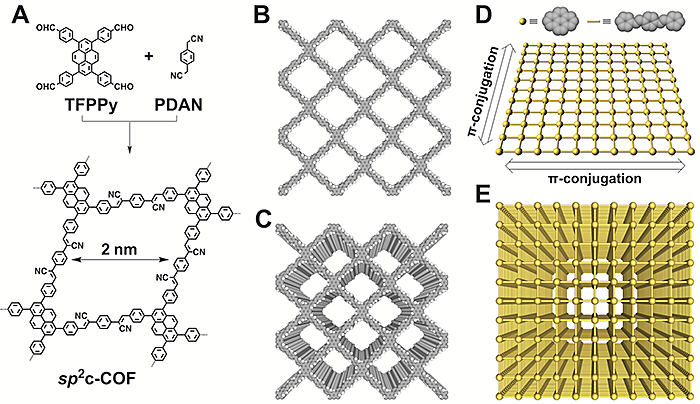Design and synthesis of two-dimensional sp2 carbon polymers
A research group led by Professor Donglin Jiang, Energy and Environment Area, Japan Advanced Institute of Science and Technology (JAIST, President Tetsuo Asano), succeeded in the design and synthesis of two-dimensional sp2 carbon covalent organic frameworks.
Carbon materials are attracting great attention as a platform for developing various functional materials. Among them, two-dimensional (2D) carbon materials owing to their unique chemical and electric structures, have been the core material of competitive researches over the world. Especially, graphene, consisting of all sp2 carbon fused atomic sheets with specific electric conductivities, has been used for broad applications in various fields. However, using a chemical approach to prepare sp2 carbon sheets with ordered structures of sp2 carbon or sp2 carbon-based units is hardly achieved. A 2D carbon material is still limited to only graphene.
In this research, Dr. Enquan Jin, a postdoctoral researcher of the Jiang group, has established the principle for designing a 2D sp2 carbon polymer by developing topology diagram-based reticular chemistry, and explored a methodology for synthesizing the 2D sp2 carbon polymers by connecting of sp2 carbon units in an ordered manner. This approach makes it possible to chemical synthesis of 2D carbon materials that are not available by using conventional methods, and opens a way to tailor-made 2D carbon materials based on the molecular design of sp2 carbon building blocks. The resulting 2D carbon polymers possess ordered molecular structures with 2D sp2 carbon frameworks and feature extended π conjugation over the 2D atomic layers. The 2D sp2 carbon polymers are highly stable in air, various organic solvents, water, acid, and base. Figure 1.A) Synthesis of 2D sp2 carbon polymer with sp2 carbon units. B) Atomic layer of 2D sp2 carbon polymer. C) Structure of stacked 2D carbon framework. D) Model of 2D sp2 carbon atomic layer. The π conjugation is extended along the x and y directions. E) Model structure for the layered 2D sp2 carbon frameworks.
Figure 1.A) Synthesis of 2D sp2 carbon polymer with sp2 carbon units. B) Atomic layer of 2D sp2 carbon polymer. C) Structure of stacked 2D carbon framework. D) Model of 2D sp2 carbon atomic layer. The π conjugation is extended along the x and y directions. E) Model structure for the layered 2D sp2 carbon frameworks.
By using conventional methods, the synthesis of sp2 carbon materials only yields three-dimensional (3D) amorphous carbons without any structural orderings. Preparation of 2D atomic layer and stacked frameworks remains a challenging goal. The research group developed a reversible C=C bond formation reaction for the polycondensation of sp2 carbon units and succeeded in the preparation of crystalline 2D sp2 carbon polygon networks (Figure 1A). The resulting sp2c-COF consists of 2D sp2 carbon atomic layer (Figure 1B) and forms stacked framework (Figure 1C). The framework constitutes pyrene π columnar arrays and ordered 1D nanochannels. In the 2D layer, the π conjugation is extended along the x and y directions to form a 2D π electric system (Figure 1D). Thus, the stacked framework creates aligned pyrene π columnar arrays (the spherical knots, Figure 1E) and 1D open channels. X-ray diffraction measurements revealed the ordered structures of the sp2c-COF.
sp2c-COF is an organic semiconducting material with a bandgap of 1.9 eV and upon doping with iodine, exhibits an increased conductivity by 12 orders of magnitude compared to undoped sample. Professor Toshikazu Nakamura at Institute for Molecular Science has involved in the studies on the radical, spin and magnetic behavior of these iodine-doped sp2c-COF samples. Electron spin resonance spectroscopy of the doping process revealed the generation of organic radicals in the system and an increasing tendency of radical signals with the doping time. These radicals are located on the pyrene units and cannot form bipolarons. Consequently, the system consists of a high density of radicals. Superconducting quantum interference device measurements revealed that the sp2c-COF is a bulk magnet in which the radical density is as high as 0.7 per pyrene unit. By contrast, the 1D and 3D amorphous sp2 carbon materials only yield very low spin density. The relationship between magnetization and applied field yielded nonlinear curves under low temperatures, indicating that these spins are capable of ferromagnetic phase transition and are aligned unidirectionally. Therefore, the spins are aligned into the same direction and trigger spin coherence in the 2D sp2 carbon polymers. These unique radical and spin behaviors originate from the crystalline 2D sp2 carbon structure and are not observed for 1D and 3D amorphous carbon materials. The highly dense spin arrays may pave a way to ultra dense data storage system and efficient energy storage or conversion systems.
This research work was published in Science, on August 18, 2017.
Reference
Enquan Jin, Mizue Asada, Qing Xu, Sasanka Dalapati, Matthew A. Addicoat, Michael A. Brady, Hong Xu, Toshikazu Nakamura, Thomas Heine, Qiuhong Chen, Donglin Jiang
Two-dimensional sp2 carbon-conjugated covalent organic frameworks, Science
DOI: 10.1126/science.aan0202.
August 21, 2017
Press Release contact:
Public Relationship office,
Japan Advanced Institute of Science and Technology 1-1, Asahidai, Nomi, Ishikawa, 923-1211
Tel :0761-51-1031
Fax:0761-51-1025
E-mail:kouhou@ml.jaist.ac.jp
